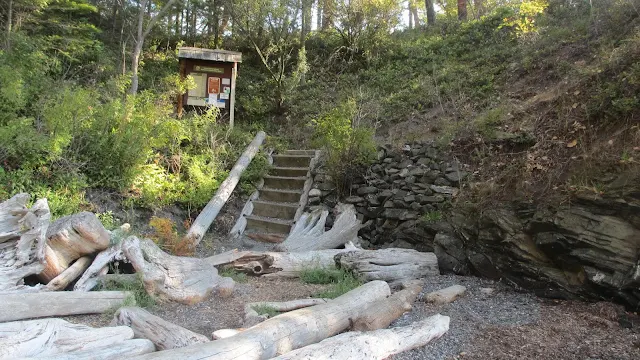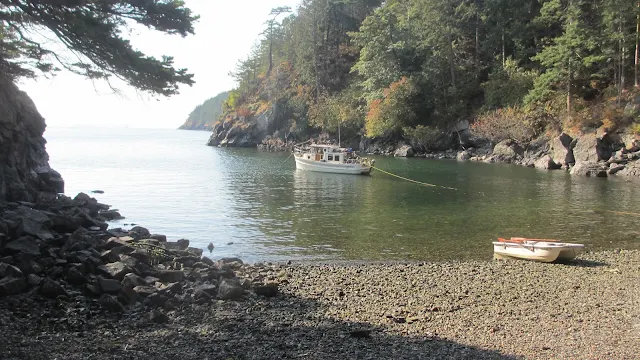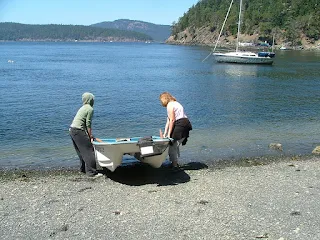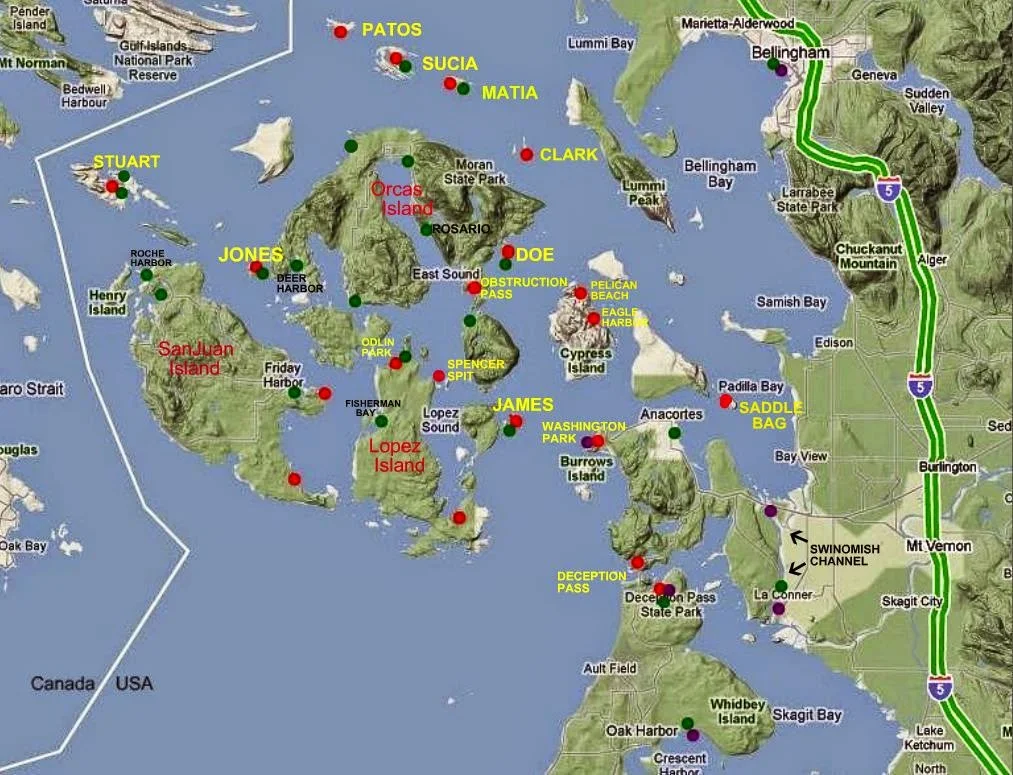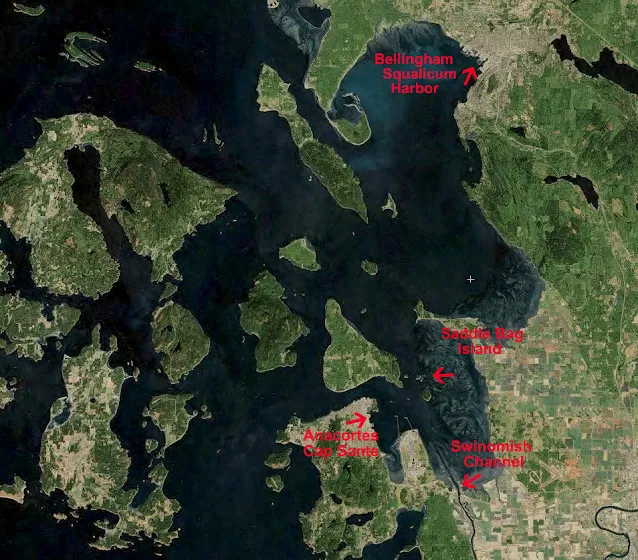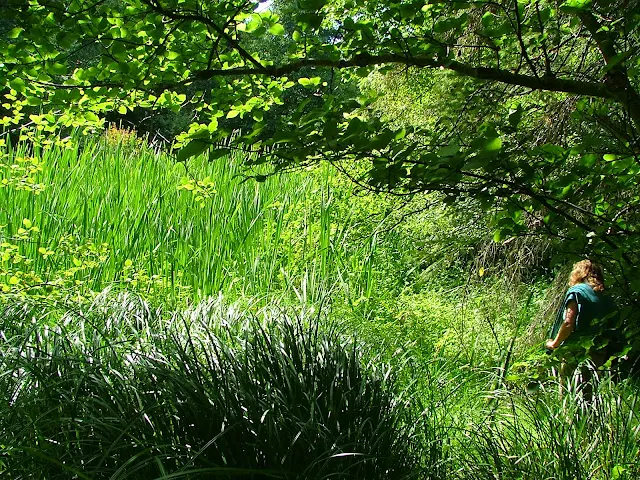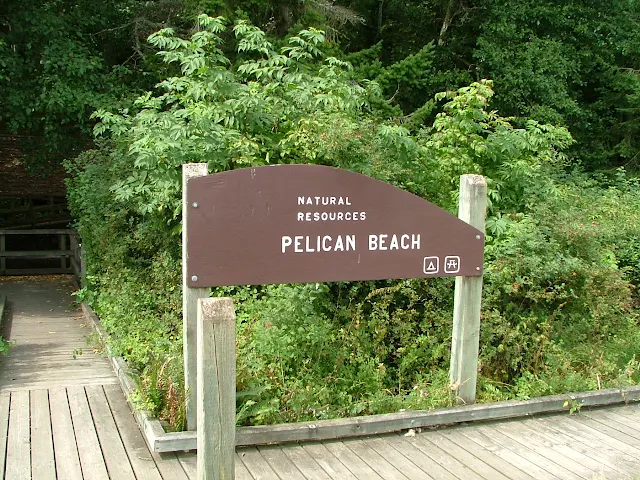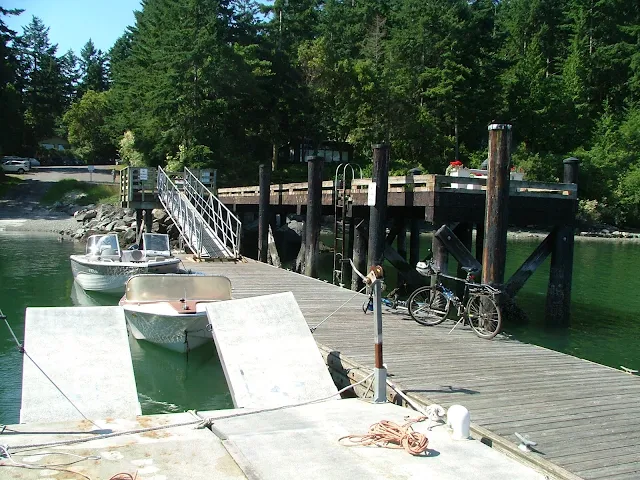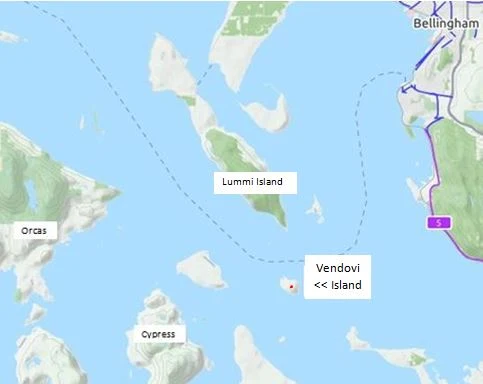Everyone knows about Rosario - Friday Harbor - Roche Harbor and Sucia Island. Of course they are famous and not to miss, but some of the best San Juan area destinations are much less traveled and even less talked about. Out of the way places have secrets where local knowledge may turn a ho-hum cruise into a truly memorable event. I am listing and describing some favorites, feel free to make them yours too.
Not in any order or preference!
#1 Saddlebag Island
At the top of Guemes Channel northeast of Anacortes in Padilla Bay is diminutive Saddlebag Island State Park.
Saddlebag has only 24 acres, its distinctive dog-bone shape creates two teeny bays. The north one suitable for two anchored boats, or only one if the skipper hogs the middle on a long rode. We have always been able to anchor fifty feet from shore. The dinghy ride is short and sweet, the gravel beach is friendly and steep. The bay catches a little flotsam and wayward seaweed so an aroma may be mixed in with treasures you find.
The narrow center isthmus holds a small campground and outhouse (newer). Hiking the shoreline trail is easy and follows a handy figure eight shape affording views in all directions. Being less than two miles from Anacortes makes Saddlebag an easy kayak destination.
The waters on the east side of Saddlebag are shallow and rock strewn, circling the island is a white-knuckle event at lower tides. Your dinghy or kayak would be a better choice than the mother ship if you are determined to gunk-hole.
We stop at Saddlebag for lunch and a hike, overnight if it is late, or just a quick anchor and hike. We always see something new, and never go away unhappy.
Saddlebag may only be rated as five star, you will be glad you stopped by.
#2 Lopez Village
Stop, don't think that I think you don't know all about Lopez Village, of course you do.
But do you know how to land your dinghy right downtown?
Many people, go to the Islander Resort or Islands Marine Center in Fisherman Bay and then walk or bicycle the 3/4 mile back to town. That's a long way to carry groceries or walk to breakfast, and you don't have to!
There is a public beach access to the village just outside the entrance to Fisherman Bay and here is how to spot it and what to do.
First you have some choices:
#1 anchor outside the Fisherman Bay entrance, but you will be waked by other boats so this is a short term at best choice. #2 anchor just inside Fisherman Bay (no wake zone) on the right side at the first corner, or anchor a little further in in front of Islands Marine Center or the Islander Resort. #3 tie up at one of the two mentioned resort docks and pay the fees. I prefer option #2 because it is protected from the wind and gives easy access to the Spit Preserve.
Once anchored or tied up to the dock, jump in the dinghy and race back outside the entrance. Run as far as the red navigation aid (dolphin) marking the safe entrance to Fisherman Bay and look towards shore, there you will easily spot a galvanized stairway way with switch back and viewing platform.
Bring the dinghy ashore right in front of the stairway. The beach to the left and right are private with signs reminding us. We drag the dinghy all the way up to the stairs and tie off on a steel support.
Once you charge up the stairs and get your bearings you will find you are right smack in the middle of the village. The fudge shop is fifty feet away and across the street is the free hot shower and bathroom supported by the Lopez Chamber of Commerce (donations accepted). Another block up the road brings you to the grocery stores. Sometimes we bring our bikes ashore here or rendezvous with others that came by ferry.
 |
| Public access beach and stairs for Lopez Village |
#3 Matia Island Trail
We all have our favorite place, trail, or experience we remember fondly. I conveniently forget the rainy foggy times, recalling just the good stuff. Matia has always been that place for me. I once said to a fellow boater that if I was stuck somewhere due to bad weather or rough seas, Matia was where I wanted to be.
Matia Island State Park is about one mile east of Sucia and a little more north of Orcas.
My preferred access is Rolf Cove on the west end. From the dock on Matia, with field glasses you can look right up Echo Bay and count the yachts at Sucia (sort of). Rolfe cove is cute, smallish, stops most wind and rogue wakes and feels homey, private and comfortable at the dock or paddling the dinghy. The rickety single pole gangplank and old wood float is quaint, but due to be replaced, and currently holds only four boats. The bay has room for three or four more at buoys or anchored.
The second less preferred but equally protected access is a large cove on the far east end, but there is no dock. (The trail is at the dinghy friendly beach at the head of the cove)
What makes Matia special is the one mile trail circling the south half of the island. Part rain forest, part sea shore, part wildlife habitat, hiking the trail is an experience worth repeating. It connects you with the island and with nature, it renews and grounds you.. Once you start down the, no dogs allowed path, you become immersed in the island and leave the world somewhere else.

#4 Bicycle Around Lummi Island
Lopez Island is known as the bicycling Island because it is less hilly than Orcas or San Juan Island, but did you know that Lummi Island is flatter by far than Lopez? It's true, the loop around the north end of Lummi is a delightful pedal along the shore the entire 7 1/2 miles. Lummi's lack of commercial development means very few cars too, and the few you do encounter will be locals that generally drive like they live there.
There are no public docks where you may tie up or come ashore, but there is a public park and beach where you can anchor and come ashore by dinghy. It is a little bit of work but well worth the effort to lug your bikes ashore. There is also a cafe and general store walking distance from the public beach.
Here is a link to a post that describes in detail >>>
How to go ashore on Lummi Island
 #5 Eastsound - the village (city)
#5 Eastsound - the village (city)
Eastsound is not visited much by boaters, few boats anchor or tie to the county dock even though it is the second largest town in San Juan county. Never the less, this artsy craftsy city is always worthy of a stopover. Eastsound has the largest store on Orcas Island, a dog park, a people park with live music festivals. Summer farmers markets, craft galleries, and loads of bistros.
Eastsound's location is great for rendezvous with friends and family arriving by car or bicycle. It is easy to spend the entire day being a tourist and then retire to the boat, a day well spent.
When you visit, plan on anchoring and rowing over to the county dock with the dinghy since the county only allows short time tie ups and no over-nighters at the float.
For those of you without a chart, map or gps, Eastsound is at the top of East Sound on Orcas Island. Simply go past Rosario until you run out of water. The dock and anchor area are in Fishing Bay on the west shore of Madrona Point.
 |
| The tiny Eastsound county dock is used mostly for dinghy landing, and is only one block to the village center and the largest food store on Orcas Island. |
#6 Vendovi Island Preserve
Vendovi Island is a small island on your chart, north of Cypress and south of Lummi. When heading out from Bellingham you probably steer around it on your way to the inner islands.
The entire island was once a private home-site, hence has never been developed. The single modest home is where the caretakers live and is off limits, the rest of the property is forest with trails leading to view points and meadows around the island.
Access is on the islands north end where a breakwater forms a bay protecting a nice float. Admission is free. This is a good place to break up your cruise and spend a few hours walking on shore or just have lunch in the gazebo. Comical Puffins live in the rocks of the breakwater and are sure to entertain you.
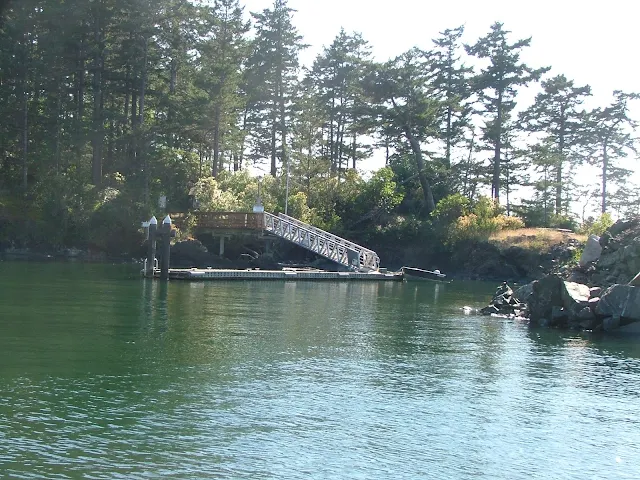 |
| Vendovi Island float |
#7 Fort Whitman on Goat Island
Fort Whitman and Battery Harrison easily win the battle for least visited and are virtually unknown except to locals. There are no signs, no brochures, no promotion. Even the state of Washington seems loath to admit its existence or encourage tourism.
According to online sources, Goat Island is managed by Washington's department of fish and wildlife, visiting is not restricted, although they prefer to not talk about it.
For gunk-holers and true explorers, Fort Whitman is tops and it is unbelievably easy to get to and access.
Follow this link to a posting detailing every last detail you need to check this place out. You will be glad you added it to your - must see/do list. Your inner child will love it.
Click here to go to >>
Fort Whitman on Goat Island
 |
| Battery Harrison at Fort Whitman on Goat Island |
Last on my list of lessor known places to visit are hikes - I mean real uphill hikes, the kind that work up a sweat and you are really glad when you finally arrive at your destination.
#7 Young Hill
Start this hike at English Camp on Garrison Bay. Begin by anchoring near the tiny dinghy dock, please don't hog the entire dock with your big yacht. Wear your hiking shoes and bring plenty of water, your going to drink all of it.
Check out the interpretive center, and grounds if this is your first visit and then get going. Walk up the trail to the parking lot and then rejoin the trail at the top of the parking lot. From now on you can't get lost or miss the trail, just keep going up, up, and up some more.
When you get to the top, it is a false top, take a break and then follow the trail up another five minutes, up to the real top.
Noticeably absent on this two hour hike are resting benches, use a handy rock or stump. Perhaps the smooth wide trail and welcome shade trees, make up for a lack, of rest stops, you decide.
 |
View of Garrison Bay from Young Hill, Mosquito Pass is barely visible,
beyond is Haro Strait, Sidney Island, and then Vancouver Island |
#8 Cypress Lake on Cypress Island
This is the longest loop hike I know of except Turtleback Mountain and the hikes in Moran State Park which of course are not accessible by boat alone.
The trails on Cypress interconnect making long and varying hikes possible. The most straight forward access to Cypress Lake is by anchoring or hooking one of 18+ buoys in Eagle Harbor, and then dinghy ashore landing at a small gravel beach on the south shore of the bay. It is an easy to spot landing because it's about the only place without grass and muck, plus there is a DNR rules and regs. sign to greet you complete with a free trail map if you are lucky. (don't steal the posted one, that's not nice)
Much of the trail to the lake is not really a trail, it is more like a rutted jeep road that steadily climbs to about 1,000 feet in a little less than two miles. It is a grinding workout but not too bad, the lake is just so so, but never the less a good destination. I don't know about fishing, let us all know in comments if you have fished it.
On the way back down be sure to take the loop side trail that leads to the old airstrip and winds through the woods past a small unnamed lake that is warm and people swim in. The once, panoramic view from the airstrip is all but gone as planted trees take hold, but the hike is a good one anyway.
I strongly suggest that you go online and find a map to print and take with you, my description will get you to Cypress Lake just fine, but the other trails are just waiting.
Cypress Island trail map
 |
| Cypress Lake |
#9 Eagle Bluff on Cypress Island
This is possibly my favorite hike and I must warn you right off that hiking to the bluff is not allowed until after July 15 each year. Apparently people affect the baby birds. Sometimes we plan our schedule so we can make this hike.
 |
| Imposing Eagle Bluff |
Eagle bluff overlooks Rosario Strait giving you great views north and south down the waterway and of course of Orcas Island. The trail is in good shape with handy steps and a short five foot ladder at a particularly steep section. As you hike you will see peek a boo peeks at clearings and drop offs, but nothing dangerous until you get to the very top, then watch your step and grab the children and pets. If you are patient or fortunate you will see eagles and ospreys soaring in the updrafts, sometimes in mock aerial attacks with siblings.
Access this extraordinary 1-2 hour hike from Pelican Beach, you won't need a map the trail is well marked.
Pelican Beach is near the north end of Cypress Island facing Sinclair Island. It is one mile north of Eagle Harbor, there are picnic tables on shore a DNR sign and a restroom in the woods. Off shore are four or six anchor buoys. You can't miss it.
Follow the link below to a posting full of pictures.
Eagle Bluff pictorial hike
Oops, did I say ten? Okay, try #10 - Sharpe Cove at Deception Pass
click here >>
Sharpe Cove
 |
| Maiden of Deception Pass at Sharpe Cove. |
That's it, if you go see these ten places and also hit the biggies like Roche and Friday Harbor, Jones, Sucia and Stuart, etc., you will have years of great cruises.
A critic once wrote:
"All the author has done is write about his favorite places" Yes, that's exactly what I have done.
John -



